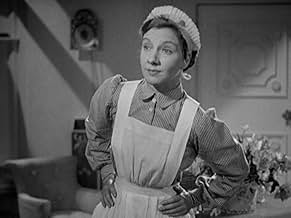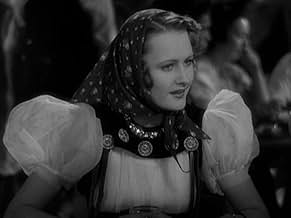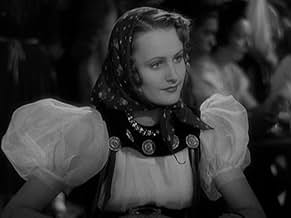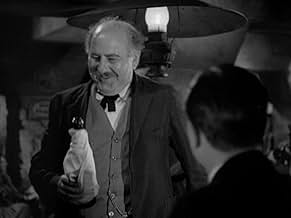IMDb रेटिंग
6.3/10
1.3 हज़ार
आपकी रेटिंग
अपनी भाषा में प्लॉट जोड़ेंA lounge singer is sent by a count to pose as a wealthy socialite.A lounge singer is sent by a count to pose as a wealthy socialite.A lounge singer is sent by a count to pose as a wealthy socialite.
Mary Philips
- Maria
- (as Mary Phillips)
Rafael Alcayde
- Hotel Clerk
- (बिना क्रेडिट के)
Nino Bellini
- Cosmos Club Waiter
- (बिना क्रेडिट के)
Agostino Borgato
- Cordellera Bar Waiter
- (बिना क्रेडिट के)
Adriana Caselotti
- First Peasant Girl
- (बिना क्रेडिट के)
Robert Cauterio
- Hotel Clerk
- (बिना क्रेडिट के)
Irene Coleman
- Cosmos Club Hat Check Girl
- (बिना क्रेडिट के)
Gino Corrado
- Cosmos Club Croupier
- (बिना क्रेडिट के)
फ़ीचर्ड समीक्षाएं
Dorothy Arzner is the director of this film, and though she does not make a lot of films, she usually makes rather substantial ones. This is certainly a substantial one.
The most appealing aspect of this production is the chemistry and loveliness of the couple played on screen by Joan Crawford and Franchot Tone (married in real life). This is not the only film that MGM has costarred them in together, but in this picture, it is easy to see the magic they create.
For his part, Robert Young is a worthy costar. And so is Joan's dazzling dress, referenced in the title. One must not forget to mention the always splendid Billie Burke, directed in several other pictures by Arzner. This time she portrays a real shrew, not her trademark scatterbrained character.
The most appealing aspect of this production is the chemistry and loveliness of the couple played on screen by Joan Crawford and Franchot Tone (married in real life). This is not the only film that MGM has costarred them in together, but in this picture, it is easy to see the magic they create.
For his part, Robert Young is a worthy costar. And so is Joan's dazzling dress, referenced in the title. One must not forget to mention the always splendid Billie Burke, directed in several other pictures by Arzner. This time she portrays a real shrew, not her trademark scatterbrained character.
In about 1980 I saw this film at the UCLA Film Archives in a series presenting Dorothy Arzner directed films. There was a guest speaker at the event who was a personal friend of Arzner's. I don't remember her name, but she was introduced as, among other things, the writer for the script of "Craig's Wife" (1936; starring Rosalind Russell).
She said she was on the set for some of the shooting of "Bride Wore Red," and described how Joan Crawford was completely uncooperative with the director. Originally it was written for Luise Rainer but for some reason she was unavailable. "So they got Joan Crawford who wasn't anything like her," and was not suited for the film in this woman's opinion. While she was on the set she witnessed how Dorothy Arzner would gently make suggestions as to how to play a scene, "...and Joan would scream, 'You'll destroy me! You'll destroy me!' and she would run up to L.B. Mayer and he would say, 'There, there Joan, play it your way." So she did, "...and frankly, the film bombed. But when you have a star that is entirely uncooperative, you can't blame the director." I hope I have quoted this woman accurately. That is what has stuck in my memory. I am a big Crawford fan, but her flaws were apparently spectacular. I just thought it would be interesting to record this bit of info.
She said she was on the set for some of the shooting of "Bride Wore Red," and described how Joan Crawford was completely uncooperative with the director. Originally it was written for Luise Rainer but for some reason she was unavailable. "So they got Joan Crawford who wasn't anything like her," and was not suited for the film in this woman's opinion. While she was on the set she witnessed how Dorothy Arzner would gently make suggestions as to how to play a scene, "...and Joan would scream, 'You'll destroy me! You'll destroy me!' and she would run up to L.B. Mayer and he would say, 'There, there Joan, play it your way." So she did, "...and frankly, the film bombed. But when you have a star that is entirely uncooperative, you can't blame the director." I hope I have quoted this woman accurately. That is what has stuck in my memory. I am a big Crawford fan, but her flaws were apparently spectacular. I just thought it would be interesting to record this bit of info.
The Bride Wore Red is based on an unpublished Ferenc Molnar play which he probably couldn't get anyone on Broadway interested in. So for a reduced rate he sold the property to MGM which gave it the usual lavish MGM treatment.
American accents which bothered some other reviewers didn't bother me. Sometimes they stand out, sometimes they don't. In this case Joan Crawford was cast in a role she played dozens of times before as the poor girl given a chance at riches and does she grab.
This variation on the Pygmalion theme starts in a café in Trieste where Crawford sings and presumably will do other things for her supper. It's in the red light district of Trieste. Count George Zucco hires her on a whim to prove that clothes and manner do make the individual. Zucco showers Crawford with a new wardrobe giving her the chance to show off those Adrian gowns and gives her two weeks at a resort in the Tyrol where the high society pleasures itself.
To make this last though Crawford has to land a husband and she lands on Robert Young. But he's slightly engaged to Lynne Carver, a sweet young thing. They're traveling with friends Reginald Owen who is a foxy old rogue and married to Billie Burke who has to watch the fox like a hawk.
The local postman Franchot Tone is interested in her, but Crawford figures to do better than him. Her only friend is a former café colleague in Mary Phillips who is working as a maid in that hotel. Though the experiment is Pygmalion like, Crawford feels more like Cinderella with the clock inevitably ticking towards midnight.
I think you can probably figure out where this all ends if you're any kind of film fan and Crawford fan. Dorothy Arzner's direction sharpens the character that Crawford created in Grand Hotel as an anxious to rise stenographer taking her couple of steps lower in society and seeing if she can make the climb.
Franchot Tone who was married to Joan Crawford at the time got a break of sorts in this film. Normally he'd be the society guy who Crawford is trying for. As the common, but somewhat erudite postman for once he's not in formal wear in a film.
Another surprise is Billie Burke who together with Mary Boland and Spring Byington was busy playing delightful airheads in her film. She's quite serious and quite good, but inevitably went back to being typecast after this film was completed.
The Bride Wore Red will please Joan Crawford fans immensely and this is a most typical example of the kind of character she played in her years at MGM.
American accents which bothered some other reviewers didn't bother me. Sometimes they stand out, sometimes they don't. In this case Joan Crawford was cast in a role she played dozens of times before as the poor girl given a chance at riches and does she grab.
This variation on the Pygmalion theme starts in a café in Trieste where Crawford sings and presumably will do other things for her supper. It's in the red light district of Trieste. Count George Zucco hires her on a whim to prove that clothes and manner do make the individual. Zucco showers Crawford with a new wardrobe giving her the chance to show off those Adrian gowns and gives her two weeks at a resort in the Tyrol where the high society pleasures itself.
To make this last though Crawford has to land a husband and she lands on Robert Young. But he's slightly engaged to Lynne Carver, a sweet young thing. They're traveling with friends Reginald Owen who is a foxy old rogue and married to Billie Burke who has to watch the fox like a hawk.
The local postman Franchot Tone is interested in her, but Crawford figures to do better than him. Her only friend is a former café colleague in Mary Phillips who is working as a maid in that hotel. Though the experiment is Pygmalion like, Crawford feels more like Cinderella with the clock inevitably ticking towards midnight.
I think you can probably figure out where this all ends if you're any kind of film fan and Crawford fan. Dorothy Arzner's direction sharpens the character that Crawford created in Grand Hotel as an anxious to rise stenographer taking her couple of steps lower in society and seeing if she can make the climb.
Franchot Tone who was married to Joan Crawford at the time got a break of sorts in this film. Normally he'd be the society guy who Crawford is trying for. As the common, but somewhat erudite postman for once he's not in formal wear in a film.
Another surprise is Billie Burke who together with Mary Boland and Spring Byington was busy playing delightful airheads in her film. She's quite serious and quite good, but inevitably went back to being typecast after this film was completed.
The Bride Wore Red will please Joan Crawford fans immensely and this is a most typical example of the kind of character she played in her years at MGM.
The plot may not be a novel one, but the title was appetising and so were the cast. 'The Bride Wore Red' was seen as part of one of many completest quests (seeing as many films not yet seen of the person in question as possible), this one being for Joan Crawford. As well as Crawford, we have other talented performers in Franchot Tone, Robert Young, George Zucco and Billie Burke. All of whom are great when with good material and in the right roles.
Although 'The Bride Wore Red' is not among the best of all involved (all have also been far worse served) or one of the best of the genre, it is still well worth watching and has a lot of positive traits. It didn't deserve to be a flop. As far as Crawford's 30s films go, which were a mixed lot in quality, 'The Bride Wore Red' somewhere around solid middle, and anybody that loves romance and comedy individually and together are likely to (not guaranteed as not everybody has the same tastes for everything) find a lot to enjoy. The case with me.
Is 'The Bride Wore Red' perfect? No. The story, despite the premise actually being good, has few surprises and can be very silly with some suspension of disbelief needed at times later on. Also felt that the start was on the dull side but once the main plot kicks in properly there is a lot more energy.
Do agree that Anni's conflict with what she wants and what she has to give up could have gone into more detail, that could have been a fascinating angle and added so much to Anni's character and given her more heart.
Crawford, looking stunning, however gives it her all without over-acting to the point of overbalancing the rest of the cast or film. She doesn't phone it in either once the plot gets going, despite being on the cold side at the beginning. Tone has one of the more likeable characters and is charming and suave. Young has some of the more juicier lines and brings a nice edge and sophistication to them. Zucco is convincingly decadent and Burke is in an atypically shrews viper sort of role and plays it to the hilt.
Found the script to be amusingly droll and that it did sparkle. The story wasn't perfect but it had energy and charm and the chemistry between the cast was beautifully pitched, the three leads work more than convincingly together. 'The Bride Wore Red' looks great, especially Crawford's wardrobe and the luminous photography. Franz Waxman's score is sumptuous without being too loud or melodramatic. Dorothy Azner's direction is a bit bland and slow to begin with, but becomes more assured as the film goes along.
Summing up, nice enough if not mind-blowing. 7/10
Although 'The Bride Wore Red' is not among the best of all involved (all have also been far worse served) or one of the best of the genre, it is still well worth watching and has a lot of positive traits. It didn't deserve to be a flop. As far as Crawford's 30s films go, which were a mixed lot in quality, 'The Bride Wore Red' somewhere around solid middle, and anybody that loves romance and comedy individually and together are likely to (not guaranteed as not everybody has the same tastes for everything) find a lot to enjoy. The case with me.
Is 'The Bride Wore Red' perfect? No. The story, despite the premise actually being good, has few surprises and can be very silly with some suspension of disbelief needed at times later on. Also felt that the start was on the dull side but once the main plot kicks in properly there is a lot more energy.
Do agree that Anni's conflict with what she wants and what she has to give up could have gone into more detail, that could have been a fascinating angle and added so much to Anni's character and given her more heart.
Crawford, looking stunning, however gives it her all without over-acting to the point of overbalancing the rest of the cast or film. She doesn't phone it in either once the plot gets going, despite being on the cold side at the beginning. Tone has one of the more likeable characters and is charming and suave. Young has some of the more juicier lines and brings a nice edge and sophistication to them. Zucco is convincingly decadent and Burke is in an atypically shrews viper sort of role and plays it to the hilt.
Found the script to be amusingly droll and that it did sparkle. The story wasn't perfect but it had energy and charm and the chemistry between the cast was beautifully pitched, the three leads work more than convincingly together. 'The Bride Wore Red' looks great, especially Crawford's wardrobe and the luminous photography. Franz Waxman's score is sumptuous without being too loud or melodramatic. Dorothy Azner's direction is a bit bland and slow to begin with, but becomes more assured as the film goes along.
Summing up, nice enough if not mind-blowing. 7/10
I had high hopes for this one. The plot sounded good. Eccentric Count Armalia (George Zucco) believes that luck of birth is all that separates the rich from the poor. To prove his point, he sets up dive singer Anni (Joan Crawford) as a fake socialite to fool his rich friends. This works but snobbish Robert Young falls for her and wants to marry her. Anni sees the chance to get out of poverty by marrying a rich guy but, at the same time, she has started to fall for poor Franchot Tone. So it becomes a question of whether Anni will choose love or money. Glossy MGM soaper with a nice cast but somehow just misses the mark. It was nice seeing George Zucco in a different kind of role. Also Billie Burke is sort of evil, which is interesting. See it for the cast or out of curiosity. You might enjoy it more than me.
क्या आपको पता है
- ट्रिवियाDuring filming, an electrician fell from the catwalk high above the set, narrowly missing the film's star, Joan Crawford. Shooting was temporarily halted while the man was rushed to hospital. Crawford refused to resume production until she was assured that the man would be fully cared for, that he would remain on salary, and that his family would be provided for. Crawford also called the hospital each day afterwards for reports on his condition.
- भाव
Rudolph 'Rudi' Pal: In my opinion, most people prefer sardines to caviar because most people haven't tried caviar.
- क्रेज़ी क्रेडिटDuring the opening credits, a music box is shown playing a tune in the background.
- कनेक्शनFeatured in The Romance of Celluloid (1937)
- साउंडट्रैकWho Wants Love?
(1937)
Music by Franz Waxman
Lyrics by Gus Kahn
Sung by Joan Crawford (uncredited) at the Cordellera Bar
Played throughout as part of the score
टॉप पसंद
रेटिंग देने के लिए साइन-इन करें और वैयक्तिकृत सुझावों के लिए वॉचलिस्ट करें
- How long is The Bride Wore Red?Alexa द्वारा संचालित
विवरण
- रिलीज़ की तारीख़
- कंट्री ऑफ़ ओरिजिन
- भाषा
- इस रूप में भी जाना जाता है
- Once There Was a Lady
- फ़िल्माने की जगहें
- ऑस्ट्रिया(Alpine exteriors)
- उत्पादन कंपनी
- IMDbPro पर और कंपनी क्रेडिट देखें
बॉक्स ऑफ़िस
- बजट
- $9,60,000(अनुमानित)
- चलने की अवधि
- 1 घं 43 मि(103 min)
- रंग
- पक्ष अनुपात
- 1.37 : 1
इस पेज में योगदान दें
किसी बदलाव का सुझाव दें या अनुपलब्ध कॉन्टेंट जोड़ें
























